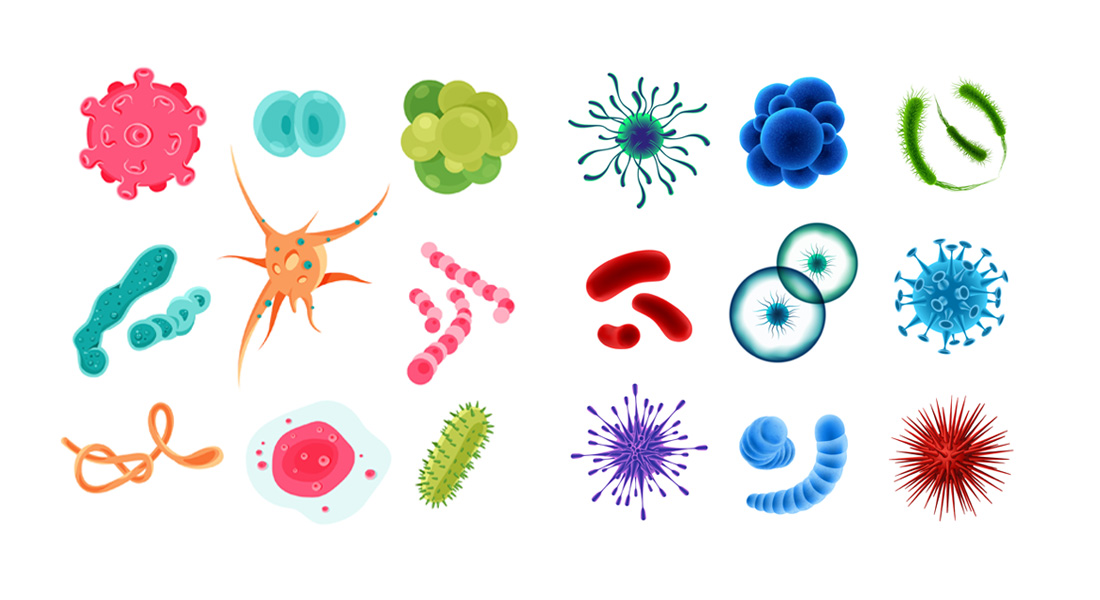Pathogenic Organisms
A pathogenic organism is any organism that is capable of causing disease in its host. Specifically, a human pathogen causes illnesses in humans. These organisms can include bacteria, viruses, fungi, and parasites.
Types of Pathogenic Organisms
1. Cocci
Cocci are spherical-shaped bacteria that can occur alone, in pairs, chains, or clusters. They are classified based on their Gram stain characteristics.
-
Gram-Positive Cocci
Staphylococcus: Causes skin infections, pneumonia, and sepsis.
Streptococcus: Responsible for strep throat, scarlet fever, and rheumatic fever.
Pneumococcus (Streptococcus pneumoniae): Causes pneumonia, meningitis, and sepsis. -
Gram-Negative Cocci
Neisseria meningitidis: Causes bacterial meningitis and septicemia.
Neisseria gonorrhoeae: Causes gonorrhea, a sexually transmitted infection.
2. Bacilli
Bacilli are rod-shaped bacteria, also classified by Gram staining.
-
Gram-Positive Bacilli
Bacillus anthracis: Causes anthrax, often through contact with infected animals or contaminated products.
Corynebacterium diphtheriae: Causes diphtheria, an upper respiratory tract infection.
Clostridium: Includes species like Clostridium tetani (tetanus) and Clostridium botulinum (botulism).
Mycobacterium: Includes Mycobacterium tuberculosis, which causes tuberculosis. -
Gram-Negative Bacilli
Escherichia coli (E. coli): Can cause urinary tract infections (UTIs) and foodborne illnesses.
Salmonella typhi: Causes typhoid fever.
Shigella dysenteriae: Causes severe diarrhea (dysentery).
Vibrio cholerae: Causes cholera, characterized by severe diarrhea and dehydration.
3. Spirochaetes
Spirochaetes are spiral-shaped bacteria with flexible bodies. They are known for their motility through axial filaments.
-
Treponema: Causes syphilis (Treponema pallidum).
-
Leptospira: Causes leptospirosis, often through contact with contaminated water.
-
Borrelia: Responsible for Lyme disease and relapsing fever.
4. Mycoplasma
Mycoplasma are unique bacteria that lack a cell wall, making them resistant to antibiotics like penicillin.
-
Mycoplasma pneumoniae: Causes atypical pneumonia, also known as "walking pneumonia."
5. Rickettsiae
Rickettsiae are small, Gram-negative, intracellular bacteria that are transmitted through insect vectors.
-
Rickettsiae: Causes typhus and spotted fever.
-
Rochalimaea: Associated with trench fever.
-
Coxiella: Causes Q fever, typically transmitted through contaminated animal products.
6. Chlamydiae
Chlamydiae are obligate intracellular bacteria that can cause a range of human diseases.
-
Chlamydia pneumoniae: Causes pneumonia.
-
Chlamydia psittaci: Causes psittacosis, transmitted from birds.
-
Chlamydia trachomatis: Causes trachoma, urogenital infections, and neonatal pneumonia.
7. Viruses
Viruses are microscopic infectious agents that can only replicate inside a host cell. They consist of genetic material (DNA or RNA) enclosed in a protein coat.
-
Pox Virus: Causes smallpox and monkeypox.
-
Herpes Virus: Includes herpes simplex virus (HSV) and varicella-zoster virus (chickenpox).
-
Adeno Virus: Causes respiratory and gastrointestinal infections.
-
Hepatitis Virus: Includes hepatitis A, B, C, D, and E, causing liver infections.
-
Picorna Virus: Causes poliomyelitis and the common cold.
-
Orthomyxo Virus: Responsible for influenza.
-
Paramyxo Virus: Causes measles and mumps.
-
Orbi Virus: Includes rotaviruses, causing severe diarrhea.
-
Rhabdo Virus: Causes rabies.
-
Retro Virus: Includes HIV, leading to AIDS.
8. Fungi
Fungi are eukaryotic organisms that can exist as yeasts, molds, or dimorphic fungi. They are classified as follows:
-
Superficial Mycosis: Affects the skin, hair, and nails (e.g., ringworm and athlete's foot).
-
Deep Mycosis: Involves internal organs, often in immunocompromised individuals (e.g., histoplasmosis and candidiasis).
9. Parasites
Parasites are organisms that live on or within a host, deriving nutrients at the host's expense. They are broadly categorized into protozoa and helminths.
-
Rhizopoda: Includes Entamoeba histolytica, causing amoebic dysentery.
-
Leishmania: Causes leishmaniasis, transmitted by sandflies.
-
Sporozoa: Includes Plasmodium species, responsible for malaria.



Free Videos